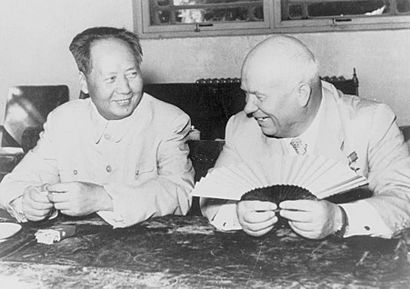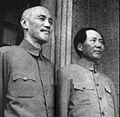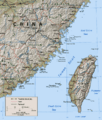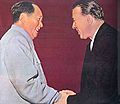Sino-Soviet split facts for kids
Quick facts for kids Sino–Soviet split |
|
|---|---|
| Part of Cold War and Sino-Soviet relations | |

Two years into the Sino–Soviet split, Chairman Mao Zedong of the PRC was host to Soviet Premier Nikita Khrushchev, in 1958.
|
|
| Date | 1956–1966 |
| Caused by | De-Stalinization of the Soviet Union, Marxist revisionism and Maoism |
| Methods | Proxy war, propaganda and Sino-Soviet border conflict |
| Resulted in | A tri-polar cold war and competition for Eastern Bloc allies |
The Sino-Soviet split (1960–1989) was a period when the friendship between two big communist countries, the People's Republic of China and the Soviet Union, fell apart. This happened during the Cold War. Eventually, China's leader, Mao Zedong, decided to end their alliance with the Soviet Union.
Contents
Early Cooperation and Growing Tensions
Before the split, the Soviet Union and China were allies. The Soviet leader, Joseph Stalin, wanted to help spread communism around the world, especially in China. During the Chinese Civil War, the Soviets first supported the Kuomintang (KMT). However, as the Communists led by Mao Zedong started winning, Stalin switched his support to them. This early hesitation by the Soviets to fully support Mao was one of the first reasons for future problems between the two nations.
The Big Break: Stalin's Death and New Leaders
The relationship changed a lot after Stalin died in 1953. Mao Zedong had seen Stalin as the main leader of communism. But even then, Mao often had a difficult relationship with the Soviet Union.
The new Soviet leader, Nikita Khrushchev, was very different from Stalin. Khrushchev wanted to make the Soviet Union more peaceful. He did not believe that capitalism would just collapse on its own, which was different from Stalin's view. Mao Zedong became very angry about this change. He wanted Khrushchev to help him fight against "imperialists," a term used for powerful Western countries.
Khrushchev refused to join Mao in this fight. Because of this disagreement, Mao decided that if Khrushchev would not cooperate, China would no longer work with the Soviet Union as an ally. This decision marked the beginning of the Sino-Soviet split.
After the Split: A New Cold War Dynamic
After the split, there was peace between the Soviet Union and China. However, they were very suspicious of each other. They were no longer allies. Mao's supporters saw this break as a victory for China. The split changed the Cold War because it created a new power dynamic. Instead of just two main powers (the US and the USSR), there were now three important players: the United States, the Soviet Union, and China.
Images for kids
-
Chairman Mao with US journalist Anna Louise Strong in 1967.
-
Soviet leader Nikita Khrushchev had different ideas from Mao Zedong.
-
China's Mao Zedong and Albania's Enver Hoxha shared similar views on communism.
-
Chairman Mao and Vice Chairman Lin Biao with Red Guards in 1966.
-
Marshal Lin Biao was an important figure in China during the Cultural Revolution.
See also
 In Spanish: Ruptura sino-soviética para niños
In Spanish: Ruptura sino-soviética para niños











